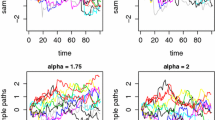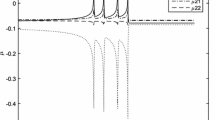Abstract
This paper proposes a Markov Chain between homogeneous Lévy processesas a candidate class of processes for the statistical and risk neutral dynamicsof financial asset prices. The method is illustrated using the variance gammaprocess. Closed forms for the characteristic function are developed and thisrenders feasible, series and option prices respectively. It is observed inthe statistical and risk neutral process is fit to data on time period of4 to 6 months in a state while this reduces to month for indices. Risk neutrallythere is generally a low probability of a move to a state with higher moments.In some cases this is reversed.
Similar content being viewed by others
References
Andersen, T. G. (1994). “Stochastic Autoregressive Volatility: A Framework for Volatility Modeling,” Mathematical Finance 4, 75–102.
Andé, T., and H. Geman. (2000). “Order Flow, Transaction Clock and Normality of Asset Returns,” Journal of Finance 55, 2259–2284.
Bakshi, G., C. Cao, and Z. Chen. (1997). “Empirical Performance of Altrernative Option Pricing Models,” Journal of Finance 52, 2003–2049.
Barndorff-Nielsen, O. (1998). “Processes of Normal Inverse Gaussian Type,” Finance and Stochastics 2, 41–68.
Barndorff-Nielsen, O., and N. Shephard. (1999). “Non-Gaussian OU Based Models and Some of Their Uses in Financial Economics,” Working Paper No. 37, Center for Analytical Finance, University of Aarhus.
Bates, D. (1996). “Jumps and Stochastic Volatility: Exchange Rate Processes Implicit in Deutschemark Options,” Review of Financial Studies 9, 69–108.
Black, F., and M. Scholes. (1973). “The Pricing of Options and Corporate Liabilities,” Journal of Political Economy 81, 637–654.
Carr, P., H. Geman, D. Madan, and M. Yor. (2000). “The Fine Structure of Asset Returns: An Empirical Investigation,” forthcoming in the Journal of Business.
Carr, P., H. Geman, D. Madan, and M. Yor. (2001). “Stochastic Volatility for Lévy Processes,” Working Paper, University of Maryland.
Carr, P., and D. B. Madan. (1999). “Option Valuation Using the Fast Fourier Transform,” Journal of Computational Finance 1, 61–73.
Clark, P. K. (1973). “A Subordinated Stochastic Process Model with Finite Variance for Speculative Prices,” Econometrica 41, 135–156.
Derman, E., and I. Kani. (1998). “Stochastic Implied Trees: Arbitrage Pricing with Stochastic Term and Strike Structure of Volatility,” International Journal of Theoretical and Applied Finance 3, 7–22.
Dupire, B. (1994). “Pricing With a Smile,” Risk 7,1, 18–20.
Duan, J, I. Popova, and P. Ritchken. (1999). “Option Pricing under Regime Switching,” Working Paper, Case Western Reserve University.
Eberlein, E., U. Keller, and K. Prause. (1998). “New Insights into Smile, Mispricing and Value at Risk: The Hyperbolic Model,” Journal of Business 71, 371–406.
Elliott, Robert J., Lakhdar Aggoun, and John B. Moore. (1995). Hidden Markov Models: Estimation and Control (Applications of Mathematics, Vol. 29). Berlin: Springer-Verlag.
Engle, R. F. (1982). “Autoregressive Conditional Heteroskedasticity with Estimates of the Variance of United Kingdom Inflation,” Econometrica, 61, 929–952.
Geman, H., D. Madan, and M. Yor. (2001). “Time Changes for Lévy Processes,” Mathematical Finance 11, 79–96.
Heston, S. L. (1993). “A Closed Form Solution for Options with Stochastic Volatility with Applications to Bond and Currency Options,” Review of Financial Studies 6, 327–343.
Madan, D. B., and E. Seneta. (1990). “The Variance Gamma (VG) Model for Share Market Returns,” Journal of Business 63,4, 511–524.
Madan, D. B., P. P. Carr, and E. C. Chang. (1998). “The Variance Gamma Process and Option Pricing,” European Finance Review 2, 79–105.
Merton, R. C. (1973). “Theory of Rational Option Pricing,” Bell Journal of Economics and Management 4, 141–183.
Merton, R. C. (1976). “Option Pricing when Underlying Stock Returns are Discontinuous,” Journal of Financial Economics 3, 125–144
Nelson, D. (1991). “Conditional Heteroskedasticity in Asset Returns: A NewApproach,” Econometrica 59, 347–370.
Author information
Authors and Affiliations
Rights and permissions
About this article
Cite this article
Konikov, M., Madan, D.B. Option Pricing Using Variance Gamma Markov Chains. Review of Derivatives Research 5, 81–115 (2002). https://doi.org/10.1023/A:1013816400834
Issue Date:
DOI: https://doi.org/10.1023/A:1013816400834




